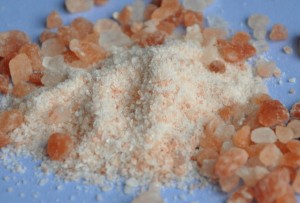Contributing Writers for Wake Up World
More and more people are realizing that the world cannot sustain itself with the current food system. With all these “convenience” foods available today, it is by no mistake that the majority of the “Western” civilization is morbidly sick. “Disease” is increasingly problematic. We can’t sit back and ignore it anymore because it is starring us right in the face. Even our government institutions are forced to tune-in to this unfortunate reality. There is a growing understanding that the world will not be able to sustain itself if we keep following this regrettable trend. In order to turn the tide, we have to take a look at some of the most fundamental things that are driving this tendency. To gain a better perspective, we first have to reflect on our eating habits.
In this never-ending list of food-like products on the market, “salt” (sodium) is in almost anything and everything that is pre-packaged. Given what is available in most of our grocery stores today, it is extremely hard to avoid, unless of course we are well versed in the subject matter. We will try our best to give you the necessary information in order to help you make more informed choices when buying salt.
What is Salt (Sodium)?
Salt as many refer to it as, is commonly known as table salt or rock salt. On the other hand, sodium is understood more so in scientific circles; it is a metallic element with a symbol Na and atomic number 11. It is a soft, silvery-white, highly reactive metal and is a member of alkali metals within “group 1” (Wikipedia). For the purposes of this article, we will focus most of our discussions on the former – salt; however, both definitions should not be treated as mutually exclusive.
The Problem with Salt in Our Diet Today
With regard to food consumption, the issue of quantity is becoming much more problematic. Salt is being consumed in large portions today, due to the fact that much of it is hidden in many of the “foods” we eat on a daily basis.
The recommended daily intake of salt is currently set at 1500 mg/day with an upper level of 2300 mg/day. The problem is most people who live in “Western society” consume much more salt than the recommended levels prescribed by our governments. In some cases, people are consuming double or even triple the upper limit (2300 mg/day). Can you believe that? If this is not a strong enough signal that our food system is heavily broken, I don’t know what is.
On top of the amount of salt being consumed, there is also the issue of the kind of salt that is being consumed. As discussed above, most people understand salt as table salt or rock salt (purchased at the local supermarket). The problem with these particular salts is that they are by no means good for you! The reason is because “table salt”, as we understand it, consists mainly of sodium chloride – a substance by which has very little benefit to us on its own. Much of the over consumption of salt is also attributed to hypertension (high blood pressure) and thus heightens our risk of stroke and/or heart attack. Further to this, much of the salt consumed is present (often times in large quantities) in much of the ready-to-eat foods on the shelf. Isolated salts such as Monosodium glutamate and the like dominate many of the isles in a grocery store. The sad part is that most people don’t have a clue what these ingredients are; fortunately there is a growing awareness thanks to all those who are passionate about nutrition and health.
The Importance of Salt
With all the bad press on salt these days, it is important not to discount all forms of salt altogether. The majority of salt that is out on the market today it highly processed, however, there are healthier options we can use.
Who says we have to eliminate salt from our diet completely? This is a foolish notion. We can still enjoy the taste, but we have to ensure that we are cognizant both of the quantity and kind being consumed. Salt plays an important role in many bodily functions. In its whole, unadulterated form, salt provides the body with many key micronutrients (minerals). In some circles, people may refer to salt as electrolytes. Salt helps us restore the minerals we lose through perspiration and physical activity. In this regard, full spectrum salt such as Celtic sea salt, deep sea Hawaiian sea salt or Himalayan salt are suitable salts to be consuming; however, we must also be cognizant of the amount we consume; after all, they contain sodium to.
“Good” vs. “Bad” Salt
As we have described above, all salts are not created equally. In an effort to help you differentiate between “good and bad” salt, we have listed below some examples of both varieties.
Good Salt
As previously described, full spectrum salts such as Himalayan salt, Celtic sea salt, or deep sea Hawaiian sea salt, are certainly healthier options if you want to season your food because they contain nearly all minerals your body is composed of. For this reason, these forms of salt have not been processed in anyway, leaving them close to their original state. Conventional table salts on the other hand have been heavily processed (heated) which eradicates the minerals that were previously present within them – thus the reason why iodine was re-added to table salt because it longer existed after processing.
If you are someone that cannot consume any form of salt altogether there are other options you can take advantage of. Salt can be found in many foods such as celery, chard, or sea vegetables. We always encourage you to first seek out your need to satisfy your body’s cry for minerals through food before other alternative forms of salt are considered. This is not to say that you can’t still enjoy salt; we all just have to make sure we are aware of how much we are consuming.
On top of the over consumption of salt, people who suffer from hypertension (high blood pressure) tend to have an improper balance of salt/potassium ratio. By this reason, those who are trying to bring down their blood pressure, consuming less salt as a first step is certainly beneficial; however, if you want to maximize the healing process, it is wise to infuse your diet with more potassium rich foods such as prunes, apricots, bananas, avocados and the like. It is recognized in certain circles that if one has too much salt in their diet they will have large bags under their eyes. On the other side of the spectrum however, if one has too much potassium, they will develop dark circles under their eyes. In assessing your situation, make sure to always observe your body.
Bad Salt
“Bad salt”, as previously noted, can wreck havoc on one’s body. Salt in any isolated form such as the conventional table salt or rock salt which has been heavily processed / treated, has been stripped of all its vital nutrients. As a result, our body’s cannot find any relief in satisfying the demand for nutrients and thus we continue to over consume salty foods that have been processed – resulting in a rather vicious cycle.
This being said, it is wise to resist the temptation of prepackaged foods as much as we can while seeking out healthier options. If this isn’t feasible, we should always strive to look at the food labels and avoid any products which have sodium or sodium isolates such as MSG listed in them.
People are becoming aware of Monosodium glutamate (MSG), and, as a result, industry has scrambled to find ways around this bad representation. Consequently, many foods still have MSG in them even though it is not listed in the ingredient list. Click here to find a list of ingredients that disguise themselves under a completely different name altogether.
Final Thoughts
It is appalling to see the amount of salt being consumed today and it is equally sad to see what it is doing to the population. Incidences of hypertension and other related illnesses are skyrocketing around the globe. Once we have all agreed to come to the realization that the majority of these cases are tied to our diets, only then can we truly “cure” this unfortunate trend through prevention by following a proper diet. When in doubt, listen to your body – as you know yourself better than anyone. Let us not be jaded by conclusions or theories from the objective world. Always look to yourself for the answers; they are always there. Remember, follow your instincts.
Your question: What type of salt do you consume, if any? (post your comment below)
Sources:
1. Prescription for Nutrional Healing; Phyllis A. Balch
2. washingtonpost.com
3. savvyvegetarian.com
About the Authors
Jordan & Kyla are passionate about health; together, they have overcome many illnesses through dietary and lifestyle changes, and the art of practicing a positive mindset daily. Kyla is currently studying to become a Registered Holistic Nutritionist and Reiki Master, and Jordan is currently learning about traditional North American medicinal herbs, in hopes of becoming a Certified Herbalist. For more information, please visit the following sites; guidinginstincts.com, Facebook, Twitter, Google+, or Pinterest

If you've found value in our articles, we invite you to support the release of our brand-new book, "Gratitude Practices for Kids: A Practical Guide for Adults to Instill a Spirit of Appreciation and Positivity in the Next Generation."
"Gratitude Practices for Kids" brings together over 25 innovative and accessible practices designed to enhance gratitude in everyday life. This comprehensive guide is backed by 17 scientific studies, ensuring each concept is grounded in research, underscoring our commitment to nurturing growth, emotional intelligence, and positive interactions between adults and children.
We encourage you to opt for the paperback version to celebrate this new release. Dive into its fresh pages away from digital distractions, allowing you to immerse yourself in the transformative practices it offers.
Over recent years, Wake Up World has faced significant online censorship, which has impacted our financial ability to operate. Moving into book publishing represents a strategic step to secure the ongoing funds needed to continue our mission. By purchasing Gratitude for Kids, you help us keep our content free and accessible to everyone, avoiding needing a paywall. With over 8,500 articles published in the last 13 years, we remain dedicated to keeping our valuable content open to all.








